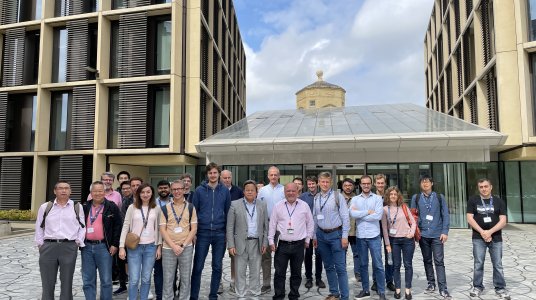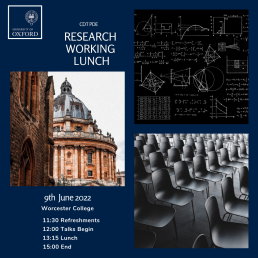Silt build up at Peel Ports locks
Abstract
Peel Ports operate a number of locks that allow ships to enter and leave the port. The lock gates comprise a single caisson structure which blocks the waterway when closed and retracts into the dockside as the gate opens. Build up of silt ahead of the opening lock gate can prevent it from fully opening or requiring excessive power to move. If the lock is not able to fully open, ships are unable to enter the port, leading to significant operational impacts for the whole port. Peel ports are interested in understanding, and mitigating, this silt build up.
Revisiting Two Classic Surface Tension Problems: Rough Capillary Rise and Fluctuations of Cellular Droplets
Prof Halim Kusumaatmaja is currently a Professor of Physics at Durham University and he also holds an EPSRC Fellowship in Engineering. Prof Kusumaatmaja graduated with a Master of Physics from the University of Leicester in 2004 and a PhD in Physics from the University of Oxford in 2008. He worked as a Postdoctoral Research Associate at the Max Planck Institute of Colloids and Interfaces (2008-2011) and at the University of Cambridge (2011-2013), before moving to Durham University and rising through the ranks from Assistant Professor (2013-2017) to Associate Professor (2017-2020) and Full Professor (2020-now). Prof Kusumaatmaja leads an interdisciplinary research group in the area of Soft Matter and Biophysics. Current research interests include wetting and interfacial phenomena, bio-inspired materials, liquid-liquid phase separation in biology, multistable elastic structures, colloidal and molecular self-assembly, and high performance computing.
Abstract
In this talk I will discuss our recent work on two problems. The first problem concerns with capillary rise between rough structures, a fundamental wetting phenomenon that is functionalised in biological organisms and prevalent in geological or man-made materials. Predicting the liquid rise height is more complex than currently considered in the literature because it is necessary to couple two wetting phenomena: capillary rise and hemiwicking. Experiments, simulations and analytic theory demonstrate how this coupling challenges our conventional understanding and intuitions of wetting and roughness. For example, the critical contact angle for hemiwicking becomes separation-dependent so that hemiwicking can vanish for even highly wetting liquids. The rise heights for perfectly wetting liquids can also be different in smooth and rough systems. The second problem concerns with droplets (or condensates) formed via a liquid-liquid phase separation process in biological cells. Despite the widespread importance of surface tension for the interactions between these droplets and other cellular components, there is currently no reliable technique for their measurement in live cells. To address this, we develop a high-throughput flicker spectroscopy technique. Applying it to a class of cellular droplets known as stress granules, we find their interface fluctuations cannot be described by surface tension alone. It is necessary to consider elastic bending deformation and a non-spherical base shape, suggesting that stress granules are viscoelastic droplets with a structured interface, rather than simple Newtonian liquids. Moreover, given the broad distributions of surface tension and bending rigidity observed, different types of stress granules can only be differentiated via large-scale surveys, which was not possible previously and our technique now enables.
PDE WORKSHOP: Stability Analysis for Nonlinear PDEs
Monday 15th August
09:30 10:30 Morning Refreshments
10:30 11:20 Session 1: Mikhail Feldman
11:30 12:20 Session 2: Cleopatra Christoforou
12:30 14:30 Lunch Break
14:30 15:20 Session 3: Jiang-Lun Wu
Tuesday 16th August
09:30 10:30 Morning Refreshments
10:30 11:20 Session 4: Jonathan Ben-Artzi
11:30 12:20 Session 5: Mikhail Perepelita
12:30 14:30 Lunch Break
14:30 15:20 Session 6: Monica Torres
Wednesday 17th August
09:30 10:30 Morning Refreshments
10:30 11:20 Session 7: Aram Karakhanyan
11:30 12:20 Session 8: Piotr Gwiazda
12:30 14:30 Lunch Break
14:30 15:20 Session 9: Cheng Yu
15:30 16:20 Session 10: Steve Shkoller (UC-Davis, USA) [online]
Thursday
09:30 10:00 Morning Refreshments
10:00 10:50 Session 11: Susana Gutierrez
11:00 11:25 Session 12: Matthew Schrecker
11:30 12:00 Morning Break (30mins)
12:00 12:25 Session 13: Timon Salar Gutleb
12:30 12:55 Session 14: Yucong Huang
13:00 14:30 Conference Lunch (90mins)
14:30 15:20 Session 15: Nicolas Dirr
15:30 16:20 Session 16: Dehua Wang (U. Pittsburgh, USA) [online]
16:30 17:00 Afternoon Break (20mins)
17:00 17:50 Session 17: Pierre-Emmanuel Jabin (Penn State, USA) [online]
18:30 21:00 Conference Dinner
Friday
09:30 10:30 Morning Refreshments
10:30 11:20 Session 18: Ewelina Zatorska
11:30 12:20 Session 19: Alexis Vasseur
12:30 12:45 Closing Remarks
13:00 ** ** Conference Lunch
Slides: Alexis Vasseur_2.pdf / Cheng Yu_1.pdf / Cleopatra Christoforou_0.pdf / Ewelina Zatorska.pdf / Jiang-Lun Wu.pdf / Jonathan Ben-Artzi.pdf / Matthew Schrecker.pdf / Mikhail Feldman.pdf / Mikhail A Perepelitsa.pdf / Monica Torres.pdf / Nicolas Dirr.pdf / Pierre-Emmanuel.pdf / Susana Gutierrez.pdf / Timon Salar Gutleb.pdf / Yucong Huang.pdf
Organisers:
Administrators:
Abstract

PDE Workshop in Stability Analysis for Nonlinear PDEs will be running Monday 15th - Friday 19th August.
Location: L3, AWB
Our goal was to bring together leading experts in the stability analysis of nonlinear partial differential equations across multi-scale applications. Some of the topics to be addressed include:
- Stability analysis of shock wave patterns of reflections/diffraction.
- Stability analysis of vortex sheets, contact discontinuities, and other characteristic discontinuities for multidimensional hyperbolic systems of conservation laws.
- Stability analysis of particle to continuum limits including the quantifying asymptotic/mean-field/large-time limits for pairwise interactions and particle limits for general interactions among multi-agent systems
- Stability analysis of asymptotic limits with emphasis on the vanishing viscosity limit of solutions from multidimensional compressible viscous to inviscid flows with large initial data.
Research Working Lunch TT22
Abstract

11:30 Refreshments (tea, coffee and homemade biscuits)
12:00 Talks (main room)
13:15 Buffet Style Lunch (incl. tea, coffee and homemade cakes)
15:00 End
Defect Central Charges
Abstract
Conformal defects can be characterised by their contributions to the Weyl anomaly. The coefficients of these terms, often called defect central charges, depend on the particular defect insertion in a given conformal field theory. I will review what is currently known about defect central charges across dimensions, and present novel results. I will discuss many examples where they can be computed exactly without requiring any approximations or limits. Particular emphasis will be placed on recently developed tools for superconformal defects as well as defects in free theories.
Hydrodynamic dispersion relations at finite coupling
It is also possible to join online via Microsoft Teams.
Abstract
Hydrodynamic excitations corresponding to sound and shear modes in fluids are characterized by gapless dispersion relations. In the hydrodynamic gradient expansion, their frequencies are represented by power series in spatial momenta. In this talk we will discuss the convergence properties of the hydrodynamic series by studying the associated spectral curve in the space of complexified frequency and complexified spatial momentum. For the N=4 supersymmetric Yang-Mills plasma at infinite 't Hooft coupling, we will use the holographic methods to demonstrate that the derivative expansions have finite non-zero radii of convergence. Obstruction to the convergence of hydrodynamic series arises from level-crossings in the quasinormal spectrum at complex momenta. We will discuss how finiteness of 't Hooft coupling affects the radius of convergence. We will show that the purely perturbative calculation in terms of inverse 't Hooft coupling gives the increasing radius of convergence when the coupling is decreasing. Applying the non-perturbative resummation techniques will make radius of convergence piecewise continuous function that decreases after the initial increase. Finally, we will provide arguments in favour of the non-perturbative approach and show that the presence of nonperturbative modes in the quasinormal spectrum can be indirectly inferred from the analysis of perturbative critical points.
From Gravitational Orbits to Quantum Scars
It is also possible to join online via Microsoft Teams.
Abstract
I will describe recent work with Zhibeodov on the boundary interpretation of orbits around an AdS black hole. When the orbits are far away from the black hole, these orbits describe heavy-light double-twist operators on the boundary. I will discuss how the dimensions of these operators can be computed exactly in terms of quasinormal modes in the bulk, using techniques from a paper to appear soon with Grassi, Iossa, Lichtig, and Zhiboedov. Then I will explain how these results are related to the concept of quantum scars, which are eigenstates that do not obey ETH.


